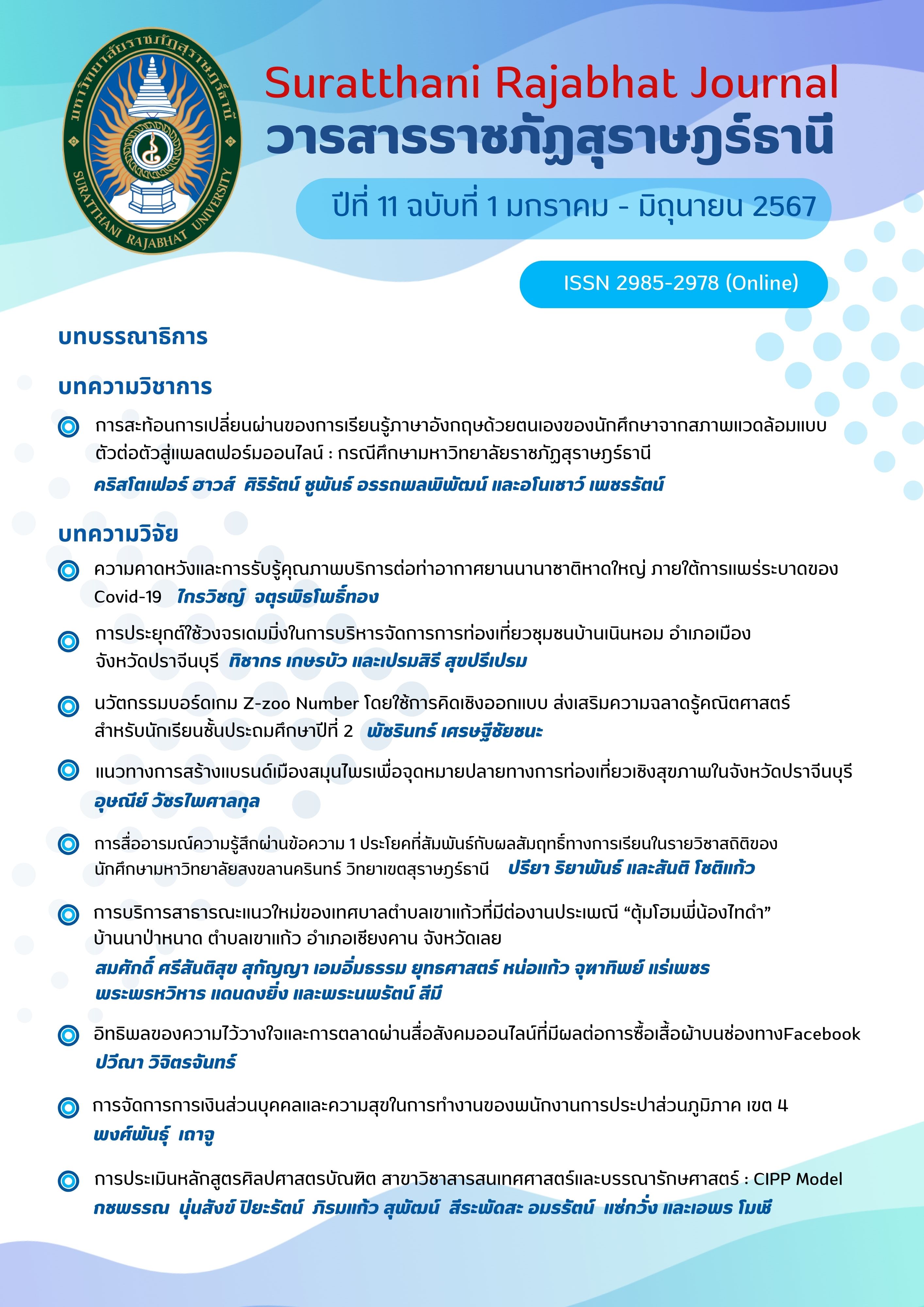Reflections on Transitioning Student Self-Access Learning From a Face-to-Face Environment to an Online Platform: A Case Study of Suratthani Rajabhat University
Main Article Content
Abstract
This academic article examines the advent and evolution of self-access learning within the English Program of the Faculty of Humanities and Social Sciences at Suratthani Rajabhat University over a twelve-year period. It begins with the physical self-access center and its accompanying directed studies program and culminates in the abrupt transition to an exclusively online platform using Google Workspace applications during the Coronavirus 2019 (COVID-19) pandemic, all framed and guided by the proficiency level standards outlined in the Common European Framework of Reference for Languages (CEFR). By focusing on the rationale for its inception, the numerous issues encountered along the way, and concluding with recommendations, this article aims to inform organizations and individual language teachers considering implementing self-access learning on their campus or within the confines of a single course.
Article Details

This work is licensed under a Creative Commons Attribution-NonCommercial-NoDerivatives 4.0 International License.
References
Atatürk University. (2021). The Oxford Placement Test: What does it measure and how?. ATAILE. https://ataile.atauni.edu.tr/wp-content/uploads/2021/04/oxford-placement-test-the-meaning-of-opt-scores.pdf
Charttrakul, K & Damnet, A. (2021). Role of the CEFR and English Teaching in Thailand: A case study of Rajabhat Universities. Advances in Language and Literary Studies Journal. 12(2), 82-89. https://www.researchgate.net/publication/351447278_Role_of_the_CEFR_and_English_Teaching_in_Thailand_A_Case_Study_of_Rajabhat_Universities
Council of Europe. (2011). Common European Framework of Reference for Languages: Learning, Teaching, Assessment. Council of Europe. https://www.coe.int/en/web/language-policy
Eby, K. (2019). The Essential Guide to Writing SMART Goals. smartsheet. https://www.smartsheet.com/blog/essential-guide-writing-smart-goals.
Fisher, D., Frey, N., & Lapp, D. (2011). Coaching middle-level teachers to think aloud improves comprehension instruction and student reading achievement. Teacher Educator, 46(3), 231-243. https://doi.org/10.1080/08878730.2011.580043
Google. (2023). Overview of Google Workspace for Education storage. https://support.google.com/a/answer/10403871?hl=en#:~:text=How%20much%20storage%20is%20included,shared%20across%20users%20and%20accounts
Jusriati, J., Nasriandi, N., Wisnu, K. & Ratna, R. (2021). The Implementation of Google Site as E-learning Platform for Teaching EFL During Covid-19 Pandemic. English Review: Journal of English Education, 10(1), 129-138. https://journal.uniku.ac.id/index.php/ERJEE/article/view/5363/2811
Knight, B. (2018). How long does it take to learn a language?. Cambridge. https://www.cambridge.org/elt/blog/2018/10/11/how-longlearnlanguage/#:~:text=For%20motivated%20adult%20learners%2C%20they,get%20to%20the%20next%20one.
McGraw-Hill. (2008). What are Accurate Descriptions of Independent, Instructional, and Frustrational Reading Levels for Individual Students?. mheducation. https://www.mheducation.com/unitas/school/program/corrective-reading-2008/corrective-reading-independent-instructional-frustrational-reading-levels.pdf
Puttra, E. (2020). The importance of learning English nowadays. https://www.researchgate.net/publication/346400434_The_Importance_of_Learning_English_Nowadays.
Scholastic Parents Staff. (2022, August 8). The Five Finger Rule for Reading Will Help Your Child Find a ‘Just-Right’ Book. Scholastic. https://www.scholastic.com/parents/books-and-reading/raise-a-reader-blog/five-finger-%20rule.html#:~:text=The%20%20number%20of%20fingers%20they,read%20aloud%20with%20a%20buddy
Singhara, I. M. (2016). Learning and Teaching English through SPEEXX Online Multimedia Program: Satisfactions and Benefits. [Online] 4th Rajabhat University National and International Research and Academic Conference (RUNIRAC IV) Kamphaeng Phet Rajabhat University, 316-324. https://dspace.bru.ac.th/xmlui/bitstream/handle/123456789/2324/Itdharom%20Mitsuvan%20Singhara.pdf?sequence=1&isAllowed=y
University of San Diego. (n.d.). 3 Basic Steps of Backward Design Lesson Plans [+ FAQs]. https://pce.sandiego.edu/backward-design-in-education/#:~:text=Backward%20design%20helps%20educators%20focus,and%20then%20designing%20the%20content.
Wicaksono, V.D., Paksi, H.P. & Supriyono. (2022). Google Sites as ICT Learning in Indonesia: The Benefits and Implementation. International Conference on Learning Innovation and Research in Basic Education, 2022, 266-289. https://knepublishing.com/index.php/KnE-Social/article/view/13303/21497
Wilson, J. (2012). English Language Major Programmes at Suratthani Rajabhat University, Thailand: An external evaluation and a proposal for reform. [Internal report: unpublished.]


